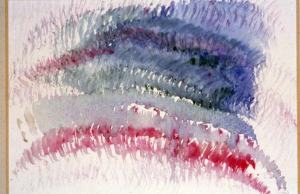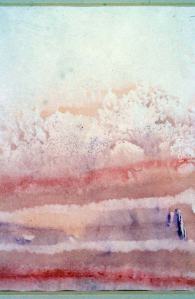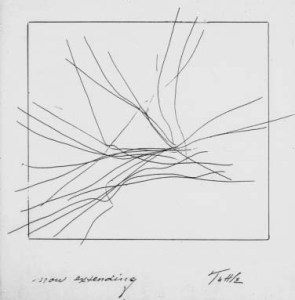For many of us in the field of Expressive Arts Therapies, helping, whether a pediatric patient or an adult in pain, is our most difficult challenge. This is why I have formulated Meditative Art Therapy an innovative mind/body technique that is effective and causes a breakthrough every time.
This article examines the healing method, Meditative Art Therapy (MAT) which combines in a very specific set of requisites* meditation practice with artistic expression to promote an individual’s capacity for self-repair.
This is achieved first, by examining art as a tool for self-expression. Second, by practicing meditation. And using the psychobiological reactions of these two aspects of the process as the mechanism for developing receptivity to unconscious messages, including the fact that both are relevant for breakthrough because of the comparable function of right brain dominance.
Working from the premise, according to years of psychological literature, the unconscious represents information symbolically, it is an appropriate lens through which to view our inner life.
There is in the Meditative Art Therapy process a paradox—that is, the individual aims to achieve both self-inspection, while at the same time self-detachment.
With an ever-increasing body of knowledge about the interrelationship of the immune system and emotion, it would seem advantageous to use and integrate this knowledge to better provide effective intervention for mental and physical health. Today’s scientific literature clearly establishes that higher nervous system centers effect astonishing changes in the body. functions.
Our bodies react to mental images in ways similar to how they react to real life images or situations. Studies of progressive relaxation reported that the same neurological pathways are excited by imagined running as by actual running. This research investigated skeletal muscle, which are under voluntary or conscious control. However, for many years, scientists have investigated pathways between the cerebral cortex where images are stored and the autonomic nervous system which controls the so-called involuntary muscles. There are also pathways between the autonomic nervous system and the pituitary and adrenal cortex. The pituitary gland secrets hormones which regulate the rate of secretion of other glands. The adrenal glands secret steroids, which regulate metabolic processes and epinephrine which causes the”fight or flight” reaction. Fear and anxiety typically trigger these cascading neurophysiologic reactions.
Through these pathways, an image held in the mind can literally affect every cell in the body.
Unlike our “thinking” mind which is left brain dominant, art is a right brain function; when visually stimulated, the right hemisphere of the brain draws out images, colors and forms that give way to insights and self-discovery. The process of Meditative Art Therapy helps the person determine the cause of imbalance and dis-ease in the body/mind by providing a mechanism for the person to “see” areas of conflict, dissatisfaction or tension involved in one’s life.
The task of reprogramming the mind to mend the body necessitates utilizing images of health.
The PROCESS of MEDITATIVE ART THERAPY: The 7 Key Requisites*
- Active role by the individual for self-repair and ultimately self-actualization
- Achievement of a daily practice of a deeper level of awareness through an altered state
- Recognition of and engagement with the symptom/illness as teacher
- Recognition of and engagement with intuitive images as the language of the spirit
- Directing the breath and the process of breathing to break up the pain
- Reframe associations, beliefs and attitudes to open the mind to a new way of seeing
- The health of the healer- the power bond between you and your client
- Active role by the individual for self-repair and ultimately self-actualization
Often it is not clear to an individual that illness, pain or discomfort are connected in any way to one’s associations or beliefs. However, once one recognizes the role played by self-defeating thought cycles in perpetrating dis-ease, revealed through one’s imagery, then one can begin to construct new associations and thereby develop a new attitude toward oneself and the pain.
Exercising the right hemisphere by coupling the creative process and meditation practice, strengthens one’s intuitive impulse—freeing the body’s energies; physiological self-control and detachment are the result.
The creative impulse, derived from combining creation and meditation, opens a pathway for communicating with the higher self. Through the meditative technique, it is possible to explore the senses rather than subdue them. Using energy from the creative impulse, it is possible to see from the images new insights.
- Achievement of a daily practice of a deeper level of awareness through an altered state
There is a deeper level of awareness achieved through an altered state of mind which is always available, yet often untapped. As expressive arts therapists, many of us have witnessed through
direct experience with native people of indigenous roots, the Shaman helping an individual transcend their ordinary definition of reality including their definition of themselves as ill.
Well-known are the physiological changes that occur as result of meditation practice.
- Recognition of and engagement with the symptom/illness as teacher
The healing process takes on a kind of illuminating facet and the illness itself a teacher. The inner life must be examined before each person can achieve well-being.
When working as research assistant in psychoneuroimmunology at Harvard Medical School,
my colleagues were spearheading the groundbreaking research about the biopsychosocial factors of the whole person. This research caused changes in treatment standards and provided
behavioral interventions which increase the individual’s coping capacities and improve the quality of life. Among these research pioneers was Dr. Jon Kabat-Zinn who would present at our staff meetings the results of his findings with the chronic pain patients, many of whom were achieving relief when traditional medical care had failed.
- Recognition of and engagement with intuitive images as the language of the spirit
What is required in this healing technique is a shift to another mode of of consciousness one that can listen in an intuitive way to messages coming from one’s own mind/body/spirit complex.
- Directing the breath and the process of breathing to break up the pain
In addition to the physiological changes which occur with meditation practice, psychologists have researched the body’s energies and their effects. For many years, these changes in the body’s electric fields have been thought to be related to health and disease. There is much historical knowledge and currently more evidence of this energy concept, commonly recognized among world cultures.
In as many variations as philosophers interpreting it, one fact is certain, there is universality as it relates to “the inward spring of movement”. The subtle activating force also know as “breath” or “vital force” when related to the body. As far back as ancient times, it always meant force, energy, breath, power. It is a vital bio-motor force.
With specialized training, an individual can learn to direct inner energies using breath. During the process of Meditative Art Therapy specific methods are employed for managing pain,, breaking it down and finding relief.
CASE STUDY
Elizabeth R. is a 51-year-old white female , married with three children and two grandchildren. She presented with a musculo-skeletal disorder (cervico-brachial) sustained from a fall. Her three year history of chronic pain left Elizabeth with “a lost zest for life and severe depression… even art, one of [her] greatest loves didn’t interest [her] anymore”.
Elizabeth enrolled in a ten-week stress reduction and relaxation program which met for two hours a week. She reports to have followed the recommended six-day-a-week schedule of mindfulness meditation practice for 20 to 40 minutes per day. During weekly meetings dress management strategies and Hatha yoga exercises were taught. Group process was a regular part of the sessions.
By the sixth week, Elizabeth privately recounted to me that she had “vivid images which raced across [her] mind”. I encouraged her to look more closely at each image to see what it might reveal. I invited her to passively observe her pain because this was her chief complaint, I recommended that she paint any and all images she could notice about the pain with objectivity.
Over sixth to eighth week of this program, Elizabeth produced a series of paintings as a result of using Meditative Art Therapy (TM). The process combines meditation with art. Elizabeth was eager to discuss the symbolic content in order to gain insight into her pain. As you will see, these paintings depicted both the pain and the breaking up of pain.
The four paintings which follow are selected from Elizabeth’s original “pain series”. She produced each one of these during the sixth week of the program always after meditation.
Her paintings reveal a pattern of color, form and a rhythm. You can appreciate the evolution of her imagery over this period of time.
For example, Elizabeth’s first paintings are characteristically pen and black ink, producing an almost completely black, dense picture. Her stokes are delicate, the visual image, sporadic.
As she shared her insights, I recorded Elizabeth’s descriptions of her art work. Her comments follow each image, #1 through #4:
Image #1:"I experienced terrific pain...this was a total feeling of pain."
Image #2:"I took a piece of it [she is referring to image #1] blew it up to get some distance on it...but I was so sick, so toxic."
Image #3:"The toxicity is spreading out. You can feel it in every muscle fiber."
Image #4:"This is shooting pain."
Elizabeth stated: “I wanted to break it up in order to see the pain better. Before meditation, I was so rigid and tight, I was numb. I couldn’t even look at the pain.” Whether figurative or literal, Elizabeth recognized her state of numbness which prevented her from moving on. “This is changing,” she reported. “The pain moves all the time now: it is constantly changing.”
The next painting, (image #5,) illustrates the possibility of an exchange or dialogue with imagery. Elizabeth begins to make inferences about the symbolic significance of her work. Elizabeth interprets the image as a skull.
Image #5:"It looks like death to me. I don't like it. I don't like to look at it."
Change requires death of the old before the new can develop. When beginning to understand any psychological/physical conflict, it is necessary to identify it first, then act on it. She continues to share her insights with this painting (image #5): “This image appeared and showed me my brain and it was filled wit black ink. As I looked more closely, the image changed and the black ink began to pour into my body, making me ill. I had been sick to my stomach for an entire day when this occurred…the significance of it said to me: my mind is making my body ill.”
Image #6:

“Through breathing, the muscles and tissues are beginning to come alive.”
Image #7:

“Life is coming back to my organs from breathing.”
Elizabeth continues to say that her life style is changing, too. Exercise, change of diet, meditation, and yoga are relieving the intense internal stress… “The dead areas are reviving.”
Image #8:

“Breathing breaks up the pain, lets it go…breathing starts layer by layer to break up the pain.”
Elizabeth’s brush strokes are more fluid and unrestricted than those in her initial paintings. The colors progress from intense black to calm yet lively quality of pastels. The paintings are “aired.” The forms pulsate with rhythm and balanced motion. The cell-like circular open shapes represent the body’s revival.
In contrast to the past, Elizabeth, in her more recent paintings draws on her instincts and consciously directs the development toward wholeness. Elizabeth believes her paintings “go beyond [her] intention.” They have a revealing quality to them. “ There seems to be a sense of peace and thought in them that really excites me!”
Elizabeth describes the last one of this series, “This one is called Now Extending. Its often reminds me to go beyond my old self. I can extend my self to people and the world.”
Image #9:
- Reframe associations, beliefs, attitudes to open the mind to new ways of seeing
Fear and anxiety trigger cascading physiologic reactions which can translate as pain. An image held in the mind’s eye can literally effect every cell in the body. A patient’s state of mind influences her immunological response. Brain cells establish new connections when we shift our thinking process and change our behaviors. The brain establishing new “wiring” then communicates in fresh new ways with other cells and before long, the pathways or wiring that kept the phobia, pain or other habit alive are replaced or altered.
7. The health of the healer-the power bond between you and your client
Physical changes occur because the patient and healer use new perceptions of the senses, symbols and the imagination to improve health. Most importantly, it is the patient’s expectancy for insight, the meaning they assign to the messages from within and faith which produces the psycho/physical changes and thereby the perception of pain also changes.
The impact factor to implementing the mind/body technique, Meditative Art Therapy, is the health of the healer. One’s own evolution physically, cognitively and spiritually must be akin to the Shaman’s way. You cannot give what you do not have or know from deep within. This is why the training program begins with the flow and cultivation of the healer’s energy. Readying the mind, opening the heart, flexing the muscle of intention, directing the subtle energy with the sound of the voice, the rhythm of the breath itself and something much more. In combination, these elements trigger an altered state so that the intuitive side of our consciousness finds its fullest play.
SUMMARY
We can “see” through the artistic journey, the healing method, Meditative Art Therapy which combines meditation practice with artistic expression promotes an individual’s capacity for self-repair. In summary, art speaks in a symbolic language, drawn from the unconscious world of the artist’s mind. Meditation induces a “readiness,” a receptivity to hearing unconscious messages. Combined, these are a powerful tool which helps the individual discover through her own efforts, insights from her unconscious life, its symbols, its meanings. Through analysis of one’s art, an individual can learn the source and thereby the cure for the pain. The process fosters attunement of mind/body/spirit interrelatedness, illuminates available inner resources and inspires new ways of thinking, reacting and behaving.
This article only highlights the process of Meditative Art Therapy. Keep in mind, the results described are founded on the commitment of individuals to participate in the entire ten-week stress reduction and relaxation program of two-hour sessions weekly designed as the foundation which informs through didactic teaching all 7 key requisites without which the shift cannot occur.
The Author: Roxanne Daleo, PhD For further details in a presentation or to sign up for this ten week program visit: www.drroxannedaleo.com
